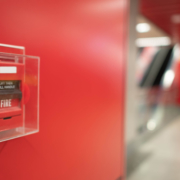Your Guide to Smart Classrooms and Fire Safety
The National Fire Protection Association (NFPA) reported that in general, fire departments respond to over 3,000 structural fires in schools each year. So, prevention and preparation have become essential for all school systems to tackle fire safety.
With many schools re-opening their doors after being remote with Covid-19, educators are re-evaluating how to use smart classrooms and fire safety technology in the case of an emergency. VFS Fire & Security Services specialized in Emergency Responder Communication Systems (ERRCS) and Public Safety Distributed Antenna Systems (DAS), which are communication systems for responders, often in the case of a fire or an active shooter.
The rise in school technology
Smart classrooms have become the new norm. Say goodbye to chalkboards because QR codes and smart boards have entered the chat. With the rise in technology and education, there are pros and cons to having smart classrooms with emergency situations like a fire or active shooter on campus.
Pros of Smart Classrooms
For example, some schools use the smartboard as a tool to teach fire safety. This downloadable template provided by ABC teach is a simple way to incorporate tech and fire safety between staff and students.
Another pro with smart classrooms is more accessible communication. If there is an emergency, most schools have upgraded from walkie-talkies to more developed communication radio systems (such as ERRCS and DAS). Communication with these systems can reach more than internal contacts, but first responders as well.
ScholarChip provides insight into the benefits of visual security at a school. They highlight the importance of a school district’s visual security for emergencies, which should include the following factors:
- “Promote a positive and innovative representation of your school through visible mobile kiosks and mobile monitoring apps.
- Enhances security mobility and real-time data for security teams and IT staff.
- Overcomes vulnerability that stems from using front desk check-in logs and unmonitored premise access.”
ERRCS & DAS
ERRCS and DAS are examples of technology working in education’s favor. Learn more about how ERRCS and DAS work on our blog.
While both systems are fairly similar, there are some slight differences between the two. Their main similarity is that they are both used within commercial and residential buildings to allow emergency responders to communicate with each other via two-way radio in areas that they may not have been able to in the past.
These systems are made of distributed antennas that are installed within a building to amplify particular radio and/or cellular signals ensuring the highest functioning communication for first responders. These antennas receive external Public Service radio signals and retransmit them within the building to ensure penetration in all areas of the building including:
- Stairwells
- Elevators
- Basements
- and other heavily shielded areas
It’s an amplification system that amplifies the radio signals between first responders’ radios during an emergency.
For example, during the events of 9/11, the need for high-functioning ERRCS/DAS systems came to the forefront of everyone’s attention.
During that tragedy, there was a lot of commotion, which highlighted the need for a tool where emergency responders can communicate without interruption or signal loss.
Previously, the requirements for ERRCS used to be that any building that was three stories or had subterranean parking would be required to be tested for ERRCS. Now, it has transitioned to where these guidelines are required for most new buildings.
Cons of Smart Classrooms
Although technology has taken the world by storm in the last year, how many teachers struggled to work Zoom?
Teachers and professors who do not have a background in technology need the time and training to fully understand how to use the equipment and programs used. In the case of an emergency, like an active shooter on campus, it’s essential that all staff are trained to respond quickly and efficiently to keep everyone safe.
Also, with the use of technology cyber crimes are more likely to happen. Government Technology reports that “With cybercriminals routinely holding school networks hostage and threatening the sensitive personal data of students, teachers, and families, only the federal government has the ability to collect and disseminate interstate data about new cyber threats, provide resources to help school districts acquire technological safeguards and work across international borders to target bad actors.”
Fire safety and smart tech
Again, prevention is key when it comes to fire safety. An education building is a huge responsibility and should be maintained to have clear pathways for an evacuation plan, frequent inspections, and be up-to-date with NFPA code.
Once a fire is detected, smart tech and communication radios can be used to alert administration and then students, who should be trained on what the fire evacuation plan is.
Emergency lighting should be a part of annual inspections. Learn why emergency lights deserve love and attention on our blog. If emergency signs aren’t properly lit during a case of a fire, it can cause confusion and be fatal.
Active shooter protocol with technology
The FBI gathered data as part of a 20 – Year review from 2000-to 2019. In the 20 years they studied, there have been 333 incidents. Out of those incidents, 62 of them happened in education environments with 419 casualties.
Clearly implementing technology correctly is crucial for the education system.
Prevention is important for all emergency situations, whether it be a fire or active shooting. The Department of Health and Human Services suggests a Multi-Tiered System of Support with the use of a student management system and smart technology. The use of this tiered system has “shown support to students who deal with the range of learning, mental health, and emotional-behavioral health concerns that a student may have.”
In the case of an active shooting, the use of mass communication systems, like ERRCS and DAS is one step towards working with the first responders. Similar to a fire evacuation plan, it’s important to make sure all students and staff are fully trained on what procedure to follow if an active shooter comes onto campus.
The education system has faced challenging years when it comes to safety and communication. The biggest key factor to remember is that fire safety equipment (and smart tech) is only as effective as its inspections. Learn why regular inspections lead to safer buildings on our blog for more information about preparing your education building.













